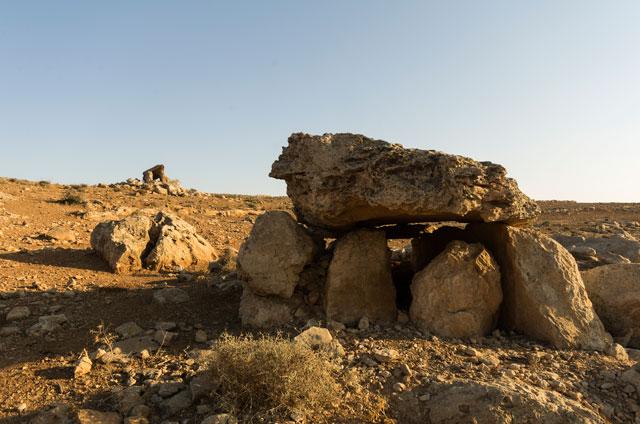You are here
Italian archaeologist explores ‘Temple of Serpents’ along Zarqa River
By Saeb Rawashdeh - Apr 12,2017 - Last updated at Apr 12,2017
AMMAN — High above the Zarqa River, the mountaintop ‘Temple of the Serpents’ gives clues to the development of human communities during the Early Bronze Age, in a key phase of human history, an Italian scholar has argued.
Deepening his knowledge of dolmens and megalithic structures at the Jabal Al Mutawwaq site located along the Zarqa River, a few kilometers southeast of Jerash and 48km north of Amman, Andrea Polcaro, a scholar from Italy, has co-directed a Spanish-Italian project since 2012.
The project began as a joint Spanish-Italian effort, Polcaro said, with Juan Ramón Muñiz from the Pontificia Facultad San Esteban in Salamanca, Spain, who co-directs the current archaeological expedition alongside the Italian.
“His [Ramon Muniz] professor, the late Juan Tresguerres Velasco, directed a Spanish expedition at the same site from 1989 for almost 20 years,” Polcaro noted.
Regarding the Jabal Al Mutawwaq site, it extended all across a mountaintop looking directly towards the river valley, in a prime location to control the movement of herds along the Zarqa River, the archaeologist said, adding that the site is close to two water springs, which are still used today by locals.
The past Spanish expedition at the site identified a village, dated to the second half of the fourth millennium BC, while also bringing to light a stone-building, called the Temple of the Serpents, which is considered one of the oldest temples of the Early Bronze Age in Jordan, he said.
“The name of the temple was originated by the presence of large jars, decorated with serpents figurines applied on the shoulder of the vessels, discovered during the excavations inside the rooms of the sacred building,” he explained.
Furthermore, the first two campaigns were focused on the exploration of the large dolmen necropolis, located around the village, along the slopes of the mountain, the expert said, underlying that “hundreds of dolmens constitute one of the larger megalithic necropolis in Jordan”.
“The most important discovery in this ancient cemetery of the fourth millennium BC has been an intact burial, recovered in a well-preserved dolmen structure, with rare funerary equipment composed of high-quality flint tools," Polcaro described.
“The excavations at the dolmen field of Jabal Al Mutawwaq had further proved the contemporaneity between the necropolis and the village, with the discovery of an ancient street, leading from the eastern gateway of the settlement towards the megalithic cemetery”, he continued.
During the campaigns of the last three years, the archaeological team also investigated the Early Bronze Age I Period village, excavating a building called Great Enclosure, a wide semi-circular wall made of large stone boulders, of almost 50 metres in diameter, enclosing an open area for cultic and economic activities; and Building C, an apsidal building with two large, circular installations dedicated to food production, Polcaro noted.
These buildings are testament to the high level of organisation reached by the Jabal Al Mutawwaq settlement during a critical phase in Jordan’s history, between the end of the Chalcolithic Period and the beginning of the urbanisation process in the Early Bronze Age, according to the scholar.
Moreover, the next campaigns of study and excavations at the site will be vital in order to investigate this important historical passage, and to better understand the inner social and ideological dynamics which led to the development of the human communities that settled along the Zarqa River in the forth millennium BC, Polcaro said.
Related Articles
AMMAN — For archaeological expert Juan Ramón Muñiz, the Spanish Archaeological Mission in Jordan is a symbol of “the cultural friendship tha
AMMAN — Spanish archaeologists have a long history of working in Jordan, and they have contributed to several discoveries in main archaeolog
Climate change has had an impact on civilisations for thousands of years, as the Jabal Mutawwaq site that dates back to 3000 BC shows, according to archaeologists.


















